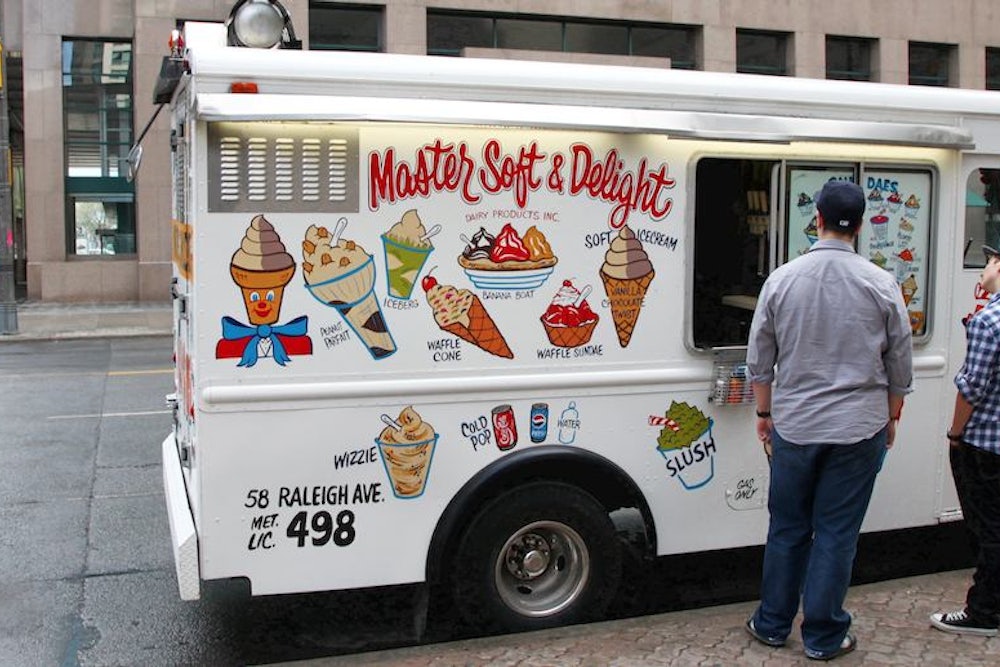This week an NPR blogpost went viral teaching us that “Turkey in the Straw,” an American folk song dating to the early 1800s and played by so many ice cream vans today, is actually a hidden racist taunt. The writer, Theodore R. Johnson, has unearthed “Nigger Love a Watermelon, Ha! Ha! Ha!,” a most unfortunate version of the song from 1916, and he also points to a nationally famous version that was practically the theme song of the minstrel show for much of the nineteenth century. Depicting a dancing black man character, the song was called—get ready—”Zip Coon.”
As interesting as it may be that today’s most popular ice crime truck jingle started out as racist abuse set to music, the facts don’t really support it.
“The first and natural inclination, of course, is to assume that the ice cream truck song is simply paying homage to ‘Turkey in the Straw,’” Johnson argues, “but the melody reached the nation only after it was appropriated by traveling blackface minstrel shows. There is simply no divorcing the song from the dozens of decades it was almost exclusively used for coming up with new ways to ridicule, and profit from, black people.”
But that divorce is indeed possible. Johnson makes it sound like the “Turkey in the Straw” version vanished in the wake of the racist ones, but it always existed alongside and has outlived them. All evidence points to “Turkey in the Straw” being what the ice cream companies intended. In pop culture of the early twentieth century, that tune is eternally associated with either its inoffensive, nonsensical lyrics or, when performed instrumentally, with farm animals and rural settings. For example, the man who scored Looney Tunes, Carl Stalling, used “Turkey in the Straw” constantly in scenes on farms and especially with chickens and the like. To grow up watching these cartoons was to have the tune hammered into one’s head, especially by Foghorn (“I say, that’s a joke, son!”) Leghorn.
So, what evidence supports the idea that in the 1920s, when these ice cream trucks became established, publicity executives were actually thinking of anti-“darky” doggerel when deciding what song the trucks would play?
Johnson’s unearthing of the “Nigger Love a Watermelon” song is invaluable as history, but the likelihood that this is what the trucks were playing is negligible. The tune has been set to innumerable verses of various kinds, and this “Watermelon” rendition was, in the grand scheme of things, one of the vast majority of pop songs that comes and goes in a flash. That’s why it’s a rare archival find and historical footnote today.
Johnson’s wiser implication is that the “Zip Coon” version was what the trucks were playing. But with “Turkey in the Straw” as a universally beloved lyric at the time, that’s a tough case to make, and he does so with only a single statement. He notes, almost in passing, “19th century ice cream parlors played the popular minstrel songs of the day.” Is that really true? Johnson gives no evidence, and it sounds like a stretch. One source of misinterpretation may be what was meant 100 years ago by “minstrel song.”
We are justifiably appalled at the focus of these shows on caricatures of black people as near-animals, but what makes it worse is that until about 1900, minstrel shows were essentially general entertainment. Audiences got a dose of comedy, dance, song, and much else: the shows occupied roughly the place that TV variety shows did from the fifties through the seventies, but with the blackface business as a foundational, horrific element of it all. It was as if “The Carol Burnett Show” had been performed with everybody corked up.
But what this means is that if there is a reference somewhere to ice cream parlors playing “minstrel songs,” this could easily refer to what a nineteenth-century person would have processed as what we call “pop.” Hardly everything sung in a minstrel show was about “coons” and “prancing”—one also heard sentimental ballads, peppy little marches, and other kinds of songs. There was no radio or TV, and recordings were short, lousy, and expensive. Live performance was the only way audiences of the time could hear music. They naturally wanted more from a show than just jibes about “Negroes.”
Now some might still find the idea compelling that ice cream parlors specialized in racist music—and remember, the idea has to be that ‘Negro’ caricature was associated especially closely with ice cream, rather than having a beer or going on a boatride. But we have to really imagine what that would mean. Was it really a custom for ice cream parlors to have someone sitting at the piano singing in black dialect about “darkies” eating watermelon and having razor fights? Let’s allow it could have been the custom at one of them somewhere—or just perhaps it was a rather obsessive quirk in some small town. But across this vast nation as a whole, was it ordinary to receive your banana split while being regaled with an endless succession of songs about coons and the ol’ plantation? And why in ice cream parlors, but not shoe stores or barbershops?
The fact that the “Turkey in the Straw” melody was fitted out with so many racist lyrics is a sad and valuable historical lesson indeed. However, the idea that today’s ice cream trucks are playing “Zip Coon”—even as unwitting historical holdover—is too fragile to launch any anti-ice-cream boycotts as we head into the summer months. After all, that would set us up for all kinds of other protests. Look up the history of good old “Eeny, meeny, miny, moe,” for example. Today we chant about catching a “tiger.” But “tiger” is a euphemism for what started as...
Image via Shutterstock.
This post has been updated.
